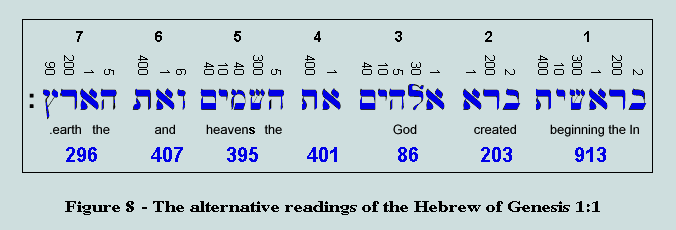

4 - THE SOLID-GNOMON / HOLLOW-CUBE SERIES
Abstract
As is made clear in 1Kings 6:20 and Revelation 21:16, the CUBE, per se, is a God-ordained symbol of HOLINESS, and it should come as no great surprise that this - the second of the five platonic solids - should figure numerically in establishing firm links between Creator and Creation.
1. Introduction
The cubes of the natural numbers form the infinite series,
C = 1, 8, 27, 64, 125, 216, 343, 512, ... whose ith term, C(i) = i^3
Any term in this series may be understood to be a stack of unit cubes - these functioning as counters. Here, for example, are representations of 216-as-cube, i.e. C(6), and 512-as-cube, i.e. C(8):

Notable derivatives of the C-series are the 1-solid-gnomons,
D = 1, 7, 19, 37, 61, 91, 127, 169, ...
- its terms formed from the differences of adjacent cubes, thus:
D(i) = C(i) - C(i-1) = (i)^3 - (i-1)^3 = 3i(i-1) + 1
[Observe, (a) that this also has a 2D interpretation as the series of numerical hexagons and, (b) that the degenerate first term, '1', is a feature of all the figurate number series]
The creation of a simple 1-solid-gnomon is explained below:

At (a), we show C(4); at (b), C(4) with C(3) inset; at (c), C(4) with C(3) removed. What remains is 64 - 27 = 37 = D(4) unit cubes. The prefix '1-' here refers to the number of these units which determine the width of the wall.
Observe that 8 such gnomons may be used to construct a hollow-cube, as demonstrated below.

At (a), 3 of the foregoing 1-solid-gnomons are combined; and at (b), a fourth is added to form a basin-like structure. This latter when copied, inverted and placed on top of (b) completes the hollow-cube, (c). In this example, the inner void has the geometry of the 6th cube.
However, following the logic of the earlier example (Figure 2), observe that 296 may also be realised as a 2-solid-gnomon, thus:

2. The 'elite series' of solid-gnomons/hollow-cubes
Two paired subsets of the cubes may be recognised as providing the source of a specific class of solid-gnomon and hollow-cube; these, for convenience, we shall refer to as the '4:3 cubes'. Here, the order numbers of the components forming a pair are 4j and 3j, respectively; j being any natural number (i.e. a positive integer). The following table reveals the early terms of these series, and their derivatives.

Observe here,
(a) the derivatives represented in columns 6 and 7 are all multiples of 37 - the multiplier, in each case, being the cube of j; this is because (4j)^3 - (3j)^3 = j.[(4j)^2 + 4j.3j + (3j)^2] = j^3.[16 + 12 + 9] = 37j^3
(b) in the present context, hollow-cubes require j to be an even number so as to ensure that the corresponding wall-thickness is a whole number - hence the missing entries in column 7
(c) as revealed earlier, a (j/2)-hollow-cube is equivalent to 8 x j-solid-gnomons
3. The significant mappings
The first 4 entries in column 6 (the 2nd and 4th repeated in column 7) are, respectively, 37, 296 (=8x37), 999 (=27x37) and 2368 (=64x37). Each has a story to tell in respect of the Creator, and of what He has told us in Genesis 1:1.
Concerning 37:
3.1 - Here we encounter a remarkable number, per se; as recorded in previous pages at this site, 37 uniform counters may be symmetrically arranged on a flat surface in 3 distinct ways; in this respect, among the integers, it is unique:
3.2 - This prime number (each of whose digits is itself a significant biblical number) is observed to permeate the Bible's opening verse, for consider:
(a) the sum of the deficiences/excesses in column 5 = 0; this means that the complete verse is a multiple of 37
(b) likewise, the sum of the first 5, and each of words 6 and 7 are multiples of 37
(c) within the first five deficiences/excesses we observe a number of combinations, each of which sum to zero
Closer examination reveals that of the 127 possible words and their combinations, 23 are multiples of 37; this is nearly7 times what probability theory leads us to expect - a fact that features dramatically in the following diagram.
Observe here the frequency of occurrence as factor of each value in the range 2 to 50 when applied to the 127 combinations. These are represented by the heights of the corresponding columns. The ideal profile - delineated by the smaller yellow squares - provides a backcloth against which the significance of each event may be assessed. Thus, in addition to noting the abundance of 37 as factor, we also observe the marked deficiency of 11.
3.3 - Both Name and Title of the Creator are multiples of 37, thus:
888 = 24 x 37; 1480 = 40 x 37: and 2368 = 64 x 37 (this last is all the more remarkable since 37-as-hexagon is a 2D representation of 64-as-cube).
Concerning 296:
3.4 - Here we have the precise value of the 7th word of Genesis 1:1 - translated, 'the earth':

3.5 - As Figure 7 further reveals, this number is factor of both Name and Title of the Lord, thus:
888 = 3 x 296; 1480 = 5 x 296; and 2368 = 8 x 296
Concerning 999:
3.6 - As Figure 8 further reveals, this number occurs twice in Genesis 1:1; first, as the sum of words 1 and 3, and again, as the sum of words 2, 4 and 5. Interestingly, 703 - the sum of the two final words - is equal to 999 - 296!
Concerning 2368:
3.7 - This the Creator's number! (see Figure 7). Significantly, it is the product of 64 (seen as a 4x4x4 stack of unit cubes) and the number of unit cubes visible in a typical 2D representation of that stack!
4. Concluding remarks
The foregoing observations strongly suggest that the prime biblical references to the Creation and its Creator have been purposefully aligned with the prime symbol of holiness, the cube.
The terms co-equal, consubstantial and co-eternal which are used of the shared features of Father, Son and Holy Spirit - the Triune God of the Christian Scriptures - may be applied with equal relevance to the spatial features and dimensions of a cube. It follows that there can be little doubt concerning the identity of the author of these wonders.
Clearly, this poses formidable questions for both Christian believer and non-believer alike - particularly in respect of Genesis 1:1 whose words preceded the introduction of the Hebrew alphabetic numbering scheme by many centuries. However, it is hard to avoid the conclusion that God has chosen to reveal his being, and a little of his awesome sovereignty, in these phenomena. We read in the Apostle Paul's second epistle to Timothy, "All scripture is given by inspiration of God, and is profitable for doctrine, for reproof, for correction, for instruction in righteousness..." (2Tim.3:16). Let us observe, (a) that the numbers and their accompanying geometries are an integral part of God's Word and therefore form part of 'All scripture' and, (b) that such is the present confusion concerning what is, and what is not, true - particularly among those who count themselves as servants of Christ - that much correction is urgently needed.
The Scriptures make it clear that from time to time God has favoured selected individuals and groups with a demonstration of his supernatural powers - and that, clearly, is his prerogative. Hitherto, such spectacular events have been transitory - kept alive only in the memories of those who had witnessed them and, in many cases undoubtedly, to be explained away as strange, but natural, occurrences. Such understanding leads one to ask whether miracle can, in any sense, be considered an effective tool for evangelism. The Lord Jesus apparently thought it could (John 10:37,38) - and that should encourage us when we point to the material above as but one aspect of the 'standing miracle' that is Genesis 1:1; this short Hebrew sentence encapsulating a supernatural event that is open to all who would 'come and see'.
Jesus declared that he alone was the way, the truth, and the life (John 14:6). May the Holy Spirit lead us all to believe that fact, for there can be none more important!
Vernon Jenkins MSc
2007-02-15
email: vernon.jenkins@virgin.net